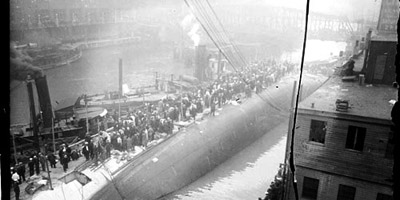Tipping point
What’s the worst single disaster in terms of the loss of human life in the history of Chicago? You might say the Chicago Fire or the Iroquois Theater Fire. You’d be wrong. This summer marks the 80th anniversary of the Eastland Disaster on the Chicago River when an excursion steamer packed mostly with employees from a single company bound for a beach outing simply tipped over — crushing, trapping, or drowning 884 people in the sewage-infused river.

There’s an historic plaque a few blocks west of my office directly across the river commemorating the event, but, other than people on Haunted Chicago bus tours, few know of the tragedy. So I was pleased to see a new book on the topic. Pleased to see, that is; not so pleased to read. Jay Bonansinga’s The Sinking of the Eastland tells the tale in the narrative or “creative” non-fiction style so popular recently, but it falls flat and, at times, causes you to smirk at the overwrought pathos. And, you know, you shouldn’t be smirking at an event that wiped out 22 entire families. The problem, I think, is that Bonansinga’s story is caught — squeezed — between two mammoth master narratives. The first is the story of the Titanic (which sunk only three years before the Eastland) and all the vice-like purchase that tale has on the popular imagination these days. (Thank you very much, Leo.) The second is Erik Lawson’s The Devil in the White City, the story of the 1893 World’s Columbian Exposition which, for many readers (at least in Chicago), single-handedly defines the genre of narrative non-fiction. The Sinking of the Eastland just tries too hard to hard to make you weepy. This might be a reaction to the perplexing absence of the sinking from Chicago’s collective memory. And I suppose I don’t blame him for that. It really is odd how entire cities forget things.
Bonansinga does highlight an interesting theory on why the Eastland capsized. Indignation over the lifeboat situation on the Titantic had reached such a level in the years after that catastrophe that ships around the world were outfitted with far more lifeboats than they were designed to carry. Mostly the lifeboats hung from the top decks, dangerously skewing ships’ centers of gravity. It almost defies belief that so many people could die on a boat still tied to the wharf, but this lifeboat top-heaviness, coupled with a too-crowded ship and improper ballasting, was all it took to pitch the Eastland into the drink.













